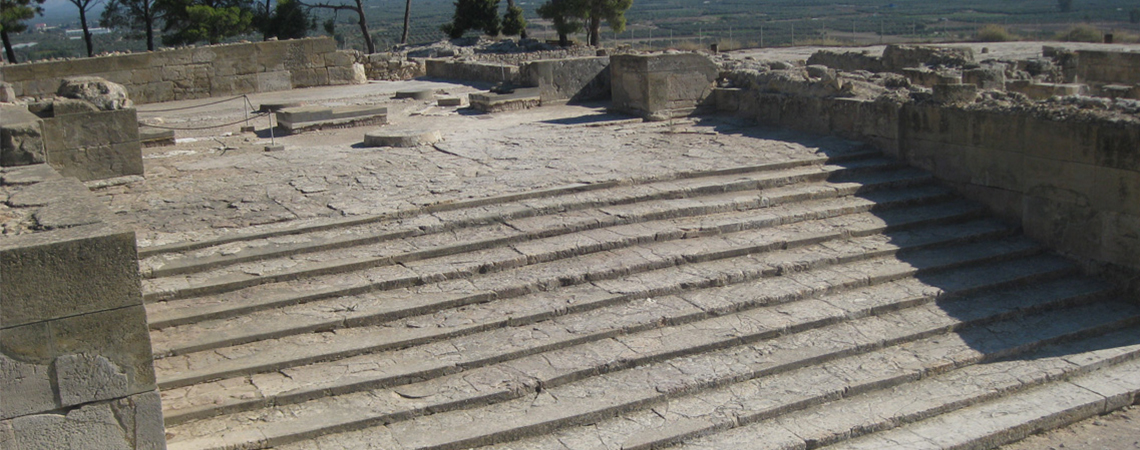
The archaeological site of Phaistos is located in Phaistos Municipality. A theatral area with basic similarities to that of Knossos is also found in the Palace of Phaistos, specifically in the West Court. It was built during the Protopalatial period and continued in use into Neopalatial times.
Visitors enter the Palace from the area known as the Upper West Court, which was used in both the Old and New Palace. From the east side of the Upper Court an imposing staircase leads to the West Court. A high, well-built wall that served as the retaining wall of the Upper Court (on a higher level than the West Court) was used to configure the theatral area of the Palace, which consists of 8 wide steps. Spectators sat on these steps and watched the events taking place in the West Court: religious ceremonies, sacred dances or athletic games.
This paved court is crossed by two slightly raised processional causeways, one leading to the Propylon of the Palace, and the other angling off it to the west. A great staircase, perhaps the most magnificent of the Minoan period, connects the West Court to the monumental Propylaea of the New Palace.
The theatral area was discovered during the first phase of the excavations by the Italian School of Archaeology in the early 20th century. Test trenches were also opened during the second phase of the School’s excavations in the 1950s and 1960s.
Conservation and consolidation work has been carried out by the Italian School of Archaeology throughout the course of the excavations (the retaining wall of the court was restored in the 1930s), while an extensive conservation programme has been implemented in recent years by the 23rd Ephorate of Prehistoric and Classical Antiquities.
During the Occupation, German archaeologists held a performance of ancient tragedy here – there are even photographs of the event.
The monument is preserved in good condition and is open to the public.
Maria Bredaki
Archaeologist
Minoan Palace of Phaistos
Theatre
In the Palace of Phaistos, specifically in the West Court, is a theatral area with basic similarities to that of Knossos. It was built during the Protopalatial period and continued in use into Neopalatial times. It consists of 8 wide steps on which spectators sat and watched the events taking place in the West Court: religious ceremonies, sacred dances or athletic games.
23rd Ephorate of Prehistoric and Classical Antiquities and Italian School of Archaeology at Athens.
1. L. Pernier, Il Palazzo Minoico di Festos, I, Roma 1935.
2. L. Pernier – L. Banti, Il Palazzo Minoico di Festos, II, Roma 1951.
3. Α. Κάντα, Φαιστός, Αγία Τριάδα, Γόρτυνα, Αθήνα 1998, pp. 21-23.
The archaeological site of Phaistos is located in Phaistos Municipality.
Built during the Protopalatial period and continued in use during the Neopalatial period.
A theatre area with basic similarities to that of Knossos is also found in the Palace of Phaistos, specifically in the West Court. Visitors enter the Palace from the area known as the Upper West Court, which was used in both the Old and New Palace. From the east side of the Upper Court an imposing staircase leads to the West Court. A high, well-built wall that served as the retaining wall of the Upper Court (on a higher level than the West Court) was used to configure the theatre area of the Palace, which consists of 8 wide steps. Spectators used these steps to watch the events. The area of the West Court was used for the performance of religious ceremonies, sacred dances, athletic games, etc. This paved court is crossed by two slightly raised processional causeways, one leading to the Propylon of the Palace, and the other angling off it to the west. A great staircase, perhaps the most magnificent of the Minoan period, connects the West Court to the monumental Propylaea of the New Palace.
Good state of preservation.
The theatre area was discovered during the first phase of the excavations by the Italian School of Archaeology at Athens in the early 20th century. Test trenches were also opened during the second phase of the School’s excavations in the 1950s and 1960s. Conservation and consolidation work has been carried out by the Italian School of Archaeology throughout the course of the excavations (the retaining wall of the court was restored in the 1930s), while an extensive conservation programme has been implemented in recent years by the 23rd Ephorate of Prehistoric and Classical Antiquities in the framework of the 3rd Community Support Fund.
Archaeological site open to the public.
During the Occupation, German archaeologists held a performance of ancient tragedy here – there are even photographs of the event.
–
35.051772°
24.813915°